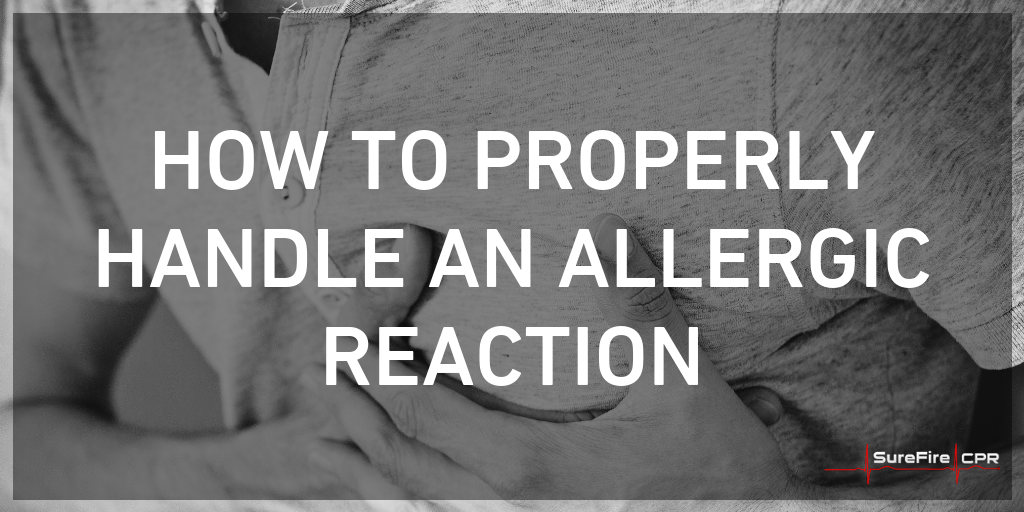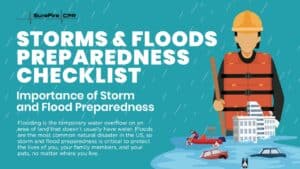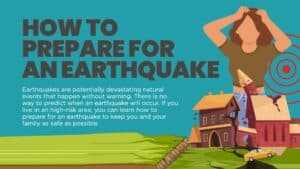Of the many unwanted accidents, injuries, and ailments that can befall the human body, few are more common than allergies. In fact, data collected by the Centers for Disease Control and Prevention (CDC) reports that over 50 million Americans suffer from allergies each year. Caused by the body’s overactive immune system, allergic reactions can occur in response to a number of different substances ranging from bee stings and house pets to pollen and peanuts. At times mild and at other times deadly, allergic reactions span the spectrum of intensity. No matter how severe an allergic reaction is, it’s important to address it as efficiently and effectively as possible to prevent distress and discomfort.
Handling an allergic reaction that happens to you or someone you know starts with identifying symptoms and understanding individual allergic predispositions. It ends with knowing proper protocol. In this guide, our emergency response experts at SureFire CPR provide you with everything you need to know to properly handle an allergic reaction. Gain the necessary knowledge to stay safe in the face of allergies with our guide below, and gain the experience to turn your knowledge into action by enrolling in our Basic First Aid course. Get the details here, and take on allergies the right way with our team at SureFire CPR!
What Is an Allergic Reaction?
An allergic reaction is an overreaction. More specifically, it’s the body’s overreaction to an external substance, known as an allergen. Within the body, the complex network of cells, hormones, tissues, and organs that compromise the immune system work around the clock to keep the body safe from potential threats such as infections, viruses, and diseases. But sometimes, the immune system does its job a little too well. During an allergic reaction, the body produces an excess of special substance-fighting proteins called Immunoglobulin E (IgE) antibodies. These antibodies travel to cells and release chemicals that, when combined with an allergen, prompt the body to release a compound called histamine, which is responsible for allergic reactions ranging from itching and irritation to swelling and anaphylaxis (a severe, often full-body allergic reaction).
What Causes Allergic Reactions?
An allergic reaction is caused by a combination of an allergen and the body’s reaction (or overreaction) to it. There are three primary types of allergies, each caused by different exposure to allergens. The first are ingested allergies, which occur only when an allergen is ingested orally or intravenously. Common allergens in this category include peanuts, eggs, gluten, certain types of fruit, and some medications, including penicillin. The second are contact allergies, which occur when an allergen comes into contact with the skin and causes swelling or irritation. Common allergens in this category include soaps, detergents, hair dye, and latex. (Bug bites and bee sting allergies are commonly considered to be both ingested and contact allergies.) The final and most widespread type of allergies are inhaled allergies, which occur when an individual breathes in an allergen. Common allergens in this category include pollen and pet dander.
What Are Common Allergic Reaction Symptoms?
If you’ve made it this far in the guide, you know that allergic reactions are caused by the body’s overreaction to a substance or set of substances called allergens. This “overreaction” is really an overproduction of proteins called Immunoglobulin E (IgE) antibodies, which the body uses to try to eradicate the allergen. When combined with the allergen itself, these antibodies form histamine, the substance responsible for the myriad of symptoms that can befall the body in the event of an allergic reaction. These symptoms include:
- Itching on the affected area or over the entire body
- A red or raised rash on the affected area or over the entire body
- Hives (large, pink bumps or swollen areas)
- Sneezing and watery eyes
- A runny nose
- Swelling in the mouth or throat
- Difficulty breathing or rapid breaths
- Nausea or diarrhea
- Drowsiness
In certain cases, an allergic reaction can affect multiple parts of the body at once with severe symptoms. This is known as anaphylaxis. Symptoms of anaphylaxis typically begin 5 to 30 minutes after contact with an allergen, but in some cases, they can take more than an hour to manifest. The symptoms of anaphylaxis include more severe instances of the symptoms listed above. Individuals experiecing anaphylactic shock may also become dizzy or lose consciousness. Certain individuals—such as those with known allergies, asthma, or a family history of anaphylaxis—are at an increased risk of anaphylaxis. Those who have already experienced anaphylaxis also have a higher chance of anaphylactic reaction. Often, anaphylaxis can strike suddenly and become deadly in a very short period of time. If you suspect an anaphylactic reaction, address it quickly with the medication prescribed by your physician (usually Epinephrine and/or Benadryl) and an immediate visit to a doctor’s office.
Dealing With Mild Allergic Reactions
If you or somebody in your presence is experiencing symptoms that indicate a mild allergic reaction, there are several steps you can take to treat the reaction. The first catch-all treatment is antihistamine administration. Antihistamines are over-the-counter drugs designed to inhibit the physiological effects of histamines. There are two types of antihistamines. The first and most common are H1 antihistamines, which inhibit H1 histamine receptors that contribute to most allergic reactions and mast cell-mediated disorders. Common H1 antihistamines include diphendydramine (Benadryl®), cetirizine (Zyrtec®), and several others. The second type of antihistamines, H2 antihistamines, inhibit H2 histamine receptors located in the parietal cells of the gut to reduce the production of stomach acid. Common H2 antihistamines include famotidine (Pepcid®) and Ranitidine (Zantec®).
Apart from administering antihistamines, there a number of additional steps you can take to help treat mild allergic reactions. To relieve rashes, redness, and itching, wash the affected area with lukewarm and gentle soap and apply hydrocortisone cream. For itchiness in the eyes, eye drops are another good solution for reducing irritation and improving visibility.
Dealing with Severe Allergic Reactions: When to Administer Epinephrine or Other High-Strength Medications
Though most allergic reactions can be classified as mild, some can be quite severe — and in some cases, even fatal — if not quickly and properly addressed. These severe allergic reactions require stronger medication to treat. The most common medication for treating severe allergic reactions is epinephrine (Auvi-Q ®, EpiPen®, Adrenaclick®), the only medication proven to reverse symptoms of anaphylaxis. Epinephrine should be injected at dosages recommended by a doctor.
Epinephrine aside, there are several other medications that can be used to reduce the symptoms of severe allergic reactions. These include steroids (cortisone) administered orally or intravenously in medical environments to help reduce inflammation after an anaphylactic attack. Steroids do not work quickly enough for emergency treatment, but they can be used to stop a severe reaction from returning. Fast-acting bronchodilators (known as “asthma” or “rescue” inhalers) may be used to help relieve breathing-related symptoms after epinephrine has been administered. The most popular type of bronchodilator is albuterol (Ventolin®, Proventil®, Alupent®). Note that asthma medications should not be used as an initial treatment solution to anaphylaxis. Epinephrine should always be used first.
When to Call A Doctor
If you encounter an allergic reaction that is mild or simply unexpected, it’s always a good idea to seek medical attention. When in doubt, always call a doctor. Call a doctor or emergency responders if you’ve administered epinephrine and symptoms are not diminishing, or if you do not have epinephrine on your person at the time of the reaction. Trained medical professionals will not only administer effective treatment — they will also be able to tell you what caused the allergic reaction in the first place.
When to Call 911
If symptoms presented in an allergic are severe and not diminishing, it’s important to call 911 as quickly as possible. Certain symptoms — such as loss of consciousness, repeated vomiting, or throat swelling — always warrant a 911 call if epinephrine is not on-hand or is not working.
Get Prepared: Get Certified
While the above recommendations should be enough to help you handle most allergic reactions, even the best advice is useless without practice. There is a big difference between knowing what to do and having the experience to actually do it. To get all of the necessary knowledge you need to address allergic reactions ranging from minor to severe — and to practice proper protocol for handling allergic reactions in the real world — it’s an excellent idea to enroll in a Basic First Aid course.
Led by professionals with experience administering first aid for issues including muscle and bone injuries, seizures, general trauma, and allergic reactions, a Basic First Aid course provides students with everything they need to administer aid to children and adults when emergency strikes. During a Basic First Aid course, students will learn all about injuries and ailments and how to address them properly. Students will then get the chance to practice their learned skills under the supervision of trained professionals. At the conclusion of the course, all students will obtain a Basic First Aid certification indicating that they have passed the course.
If you are unsure about your knowledge and skills when it comes to addressing allergic reactions in yourself or others, taking a Basic First Aid course will help you learn the necessary skills to keep yourself and others safe when allergies strike. You’ll also learn how to handle a number of other injuries and ailments — an essential skill set that pays dividends in the event of an emergency.
Learn More About Allergic Reactions and Enroll in Basic First Aid at SureFire CPR
Want to learn more about allergies? Have questions about how to handle an allergic reaction? Our experts at SureFire CPR are here to help. Contact us to speak with emergency response professional directly and have your questions answered. Ready to learn the skills necessary to address allergic reactions and other bodily emergencies? Get prepared and get certified with SureFire CPR Basic First Aid course. Led by the industry’s top instructors, our Basic First Aid course will give you everything you need to know to provide first aid to allergic reactions, injuries, and other trauma. Click the link above for more information about this course, explore our website to learn more about the many emergency response courses we offer, and enroll with our team at SureFire CPR today!
Sources
Allergies. The Centers for Disease Control and Prevention. https://www.cdc.gov/healthcommunication/ToolsTemplates/EntertainmentEd/Tips/Allergies.html.










